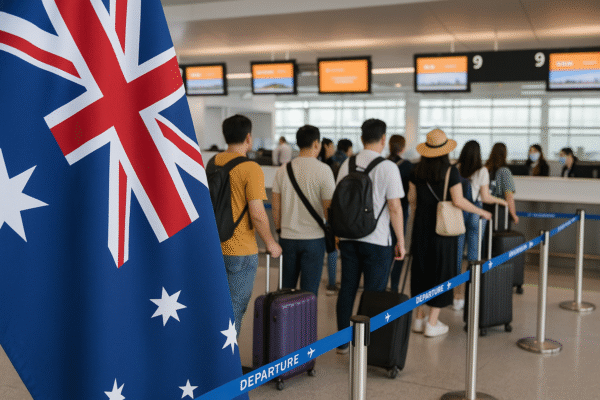The latest data from the Australian Bureau of Statistics (ABS) highlights a dramatic change in where Australians are choosing to travel in 2024–25. Long-haul destinations such as the United States are losing their edge, while Asian destinations closer to home are gaining significant momentum.
Indonesia continues to hold the crown as the most popular overseas destination for Australians, welcoming about 1.7 million visitors in the last financial year. New Zealand remained steady in second place. However, the real story is the surge of Japan, China, and Vietnam, which are rapidly climbing the rankings and reshaping the tourism map.
Japan’s Rise to Third Place
Japan has seen the sharpest growth, emerging as the third most visited country by Australians. In 2024–25, nearly 910,000 Australians travelled to Japan—almost double the 484,000 recorded in 2018–19.
A key factor in this growth is affordability. The Australian dollar traded above 100 yen at several points in 2024, making travel, accommodation, and dining in Japan far more accessible than in previous years. This favourable exchange rate allowed Australians to enjoy Japan’s mix of modern innovation, ancient tradition, world-class cuisine, and natural beauty without breaking their budgets.
The country’s appeal has always been strong, but improved affordability accelerated demand. Families, students, and adventure seekers are flocking to Japan for skiing in Hokkaido, cherry blossom festivals in Kyoto, and high-tech cultural experiences in Tokyo.
Vietnam’s Rising Popularity
Vietnam has become a rising star for Australian leisure travel. Known for its stunning coastline, vibrant food culture, and affordability, Vietnam has quickly climbed the rankings.
Direct flights from major Australian cities, favourable visa processes, and competitive holiday packages have encouraged Australians to explore destinations such as Ho Chi Minh City, Hanoi, Da Nang, and the UNESCO-listed town of Hoi An. With word-of-mouth recommendations and strong growth in social media exposure, Vietnam is expected to break further into the top tier of Australian outbound destinations in the coming years.
China’s Comeback
China reclaimed its position as a major travel destination for Australians, ranking fifth in 2024–25. This resurgence was partly fuelled by the strong presence of Chinese-Australian community ties, with many travelling to reconnect with family.
Another major boost came from the introduction of streamlined or visa-free travel arrangements, making trips to China easier than before. With diverse attractions ranging from the Great Wall and Xi’an’s Terracotta Warriors to modern megacities like Shanghai and Shenzhen, China appeals to Australians seeking both cultural and contemporary experiences.
Why the US Is Losing Ground
In contrast, the United States has seen a notable decline. Fewer than 750,000 Australians visited the US in 2024–25, a sharp drop from the pre-pandemic peak of 1.1 million in 2018–19.
High accommodation prices, longer travel distances, and the rising cost of daily expenses have all contributed to the downturn. Many Australians now perceive US entry procedures as cumbersome, and political uncertainty has dampened enthusiasm further. Business travel, once a strong contributor, has also lagged in recovery compared to leisure trips.
For cost-conscious travellers, Asia simply offers better value. A holiday in Bali, Tokyo, or Hanoi often costs a fraction of a trip to Los Angeles or New York.
Why Costs Drive Travel Decisions
Australian households are increasingly budget-conscious due to rising interest rates and living costs. This has made affordability the single most important factor when choosing destinations.
Short-haul flights to Asia, combined with lower hotel and food costs, have made places like Indonesia, Vietnam, and Japan more appealing than long-haul journeys to the US or Europe. Package deals and discount carriers have also fuelled growth in these markets, making them accessible to a broader demographic.
Indonesia: Australia’s Favourite
Indonesia remains the undisputed leader in Australian outbound travel, with Bali as its crown jewel. Its proximity, affordability, and wide range of accommodation options—from budget guesthouses to luxury resorts—make it attractive to families, honeymooners, and solo travellers alike.
With 1.7 million Australian visitors recorded in 2024–25, Indonesia continues to dominate, and this lead is expected to hold in the years ahead.
Looking Ahead to 2025
Travel experts predict the current trend will continue throughout 2025. Indonesia will likely retain its top position, while Japan, Vietnam, and China are expected to grow further as flight networks expand and tourism promotions intensify.
The US may see a modest recovery, but it will be difficult to match its pre-2019 visitor levels given the ongoing cost challenges. In contrast, Vietnam is projected to become the standout performer, with its combination of affordability, culture, and natural beauty making it one of the most exciting destinations for Australians in the coming years.
Conclusion
Australia’s outbound tourism landscape is undergoing a transformation. With Indonesia, Japan, Vietnam, and China taking centre stage, Asian destinations now dominate Australian travel preferences. The United States, once a staple in travel itineraries, is slipping behind due to cost and accessibility issues.
As affordability and accessibility remain the key decision drivers, Asia-Pacific destinations are set to hold their ground as the top choices for Australians, reshaping the global travel map well into 2025 and beyond.
For more travel news like this, keep reading Global Travel Wire
















